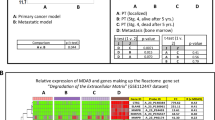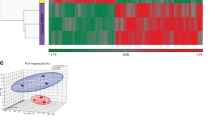Abstract
Metastatic neuroblastoma is an aggressive childhood cancer of neural crest origin. Stathmin, a microtubule destabilizing protein, is highly expressed in neuroblastoma although its functional role in this malignancy has not been addressed. Herein, we investigate stathmin’s contribution to neuroblastoma tumor growth and metastasis. Small interfering RNA (siRNA)-mediated stathmin suppression in two independent neuroblastoma cell lines, BE(2)-C and SH-SY5Y, did not markedly influence cell proliferation, viability or anchorage-independent growth. In contrast, stathmin suppression significantly reduced cell migration and invasion in both the neuroblastoma cell lines. Stathmin suppression altered neuroblastoma cell morphology and this was associated with changes in the cytoskeleton, including increased tubulin polymer levels. Stathmin suppression also modulated phosphorylation of the actin-regulatory proteins, cofilin and myosin light chain (MLC). Treatment of stathmin-suppressed neuroblastoma cells with the ROCKI and ROCKII inhibitor, Y-27632, ablated MLC phosphorylation and returned the level of cofilin phosphorylation and cell invasion back to that of untreated control cells. ROCKII inhibition (H-1152) and siRNA suppression also reduced cofilin phosphorylation in stathmin-suppressed cells, indicating that ROCKII mediates stathmin’s regulation of cofilin phosphorylation. This data demonstrates a link between stathmin and the regulation of cofilin and MLC phosphorylation via ROCK. To examine stathmin’s role in neuroblastoma metastasis, stathmin short hairpin RNA (shRNA)\luciferase-expressing neuroblastoma cells were injected orthotopically into severe combined immunodeficiency-Beige mice, and tumor growth monitored by bioluminescent imaging. Stathmin suppression did not influence neuroblastoma cell engraftment or tumor growth. In contrast, stathmin suppression significantly reduced neuroblastoma lung metastases by 71% (P<0.008) compared with control. This is the first study to confirm a role for stathmin in hematogenous spread using a clinically relevant orthotopic cancer model, and has identified stathmin as an important contributor of cell invasion and metastasis in neuroblastoma.
This is a preview of subscription content, access via your institution
Access options
Subscribe to this journal
Receive 50 print issues and online access
$259.00 per year
only $5.18 per issue
Buy this article
- Purchase on Springer Link
- Instant access to full article PDF
Prices may be subject to local taxes which are calculated during checkout







Similar content being viewed by others
References
Gutierrez JC, Fischer AC, Sola JE, Perez EA, Koniaris LG . Markedly improving survival of neuroblastoma: a 30-year analysis of 1646 patients. Pediatr Surg Int 2007; 23: 637–646.
Ara T, DeClerck YA . Mechanisms of invasion and metastasis in human neuroblastoma. Cancer Metastasis Rev 2006; 25: 645–657.
DuBois SG, Kalika Y, Lukens JN, Brodeur GM, Seeger RC, Atkinson JB et al. Metastatic sites in stage IV and IVS neuroblastoma correlate with age, tumor biology, and survival. J Pediatr Hematol Oncol 1999; 21: 181–189.
DuBois SG, London WB, Zhang Y, Matthay KK, Monclair T, Ambros PF et al. Lung metastases in neuroblastoma at initial diagnosis: a report from the International Neuroblastoma Risk Group (INRG) project. Pediatr Blood Cancer 2008; 51: 589–592.
Insall RH, Machesky LM . Actin dynamics at the leading edge: from simple machinery to complex networks. Dev Cell 2009; 17: 310–322.
Torka R, Thuma F, Herzog V, Kirfel G . ROCK signaling mediates the adoption of different modes of migration and invasion in human mammary epithelial tumor cells. Exp Cell Res 2006; 312: 3857–3871.
Kadir S, Astin JW, Tahtamouni L, Martin P, Nobes CD . Microtubule remodelling is required for the front-rear polarity switch during contact inhibition of locomotion. J Cell Sci 2011; 124: 2642–2653.
Curmi PA, Gavet O, Charbaut E, Ozon S, Lachkar-Colmerauer S, Manceau V et al. Stathmin and its phosphoprotein family: general properties, biochemical and functional interaction with tubulin. Cell Struct Funct 1999; 24: 345–357.
Belletti B, Nicoloso MS, Schiappacassi M, Berton S, Lovat F, Wolf K et al. Stathmin activity influences sarcoma cell shape, motility, and metastatic potential. Mol Biol Cell 2008; 19: 2003–2013.
Hsieh SY, Huang SF, Yu MC, Yeh TS, Chen TC, Lin YJ et al. Stathmin1 overexpression associated with polyploidy, tumor-cell invasion, early recurrence, and poor prognosis in human hepatoma. Mol Carcinog 2010; 49: 476–487.
Jeon TY, Han ME, Lee YW, Lee YS, Kim GH, Song GA et al. Overexpression of stathmin1 in the diffuse type of gastric cancer and its roles in proliferation and migration of gastric cancer cells. Br J Cancer 2010; 102: 710–718.
Saal LH, Johansson P, Holm K, Gruvberger-Saal SK, She QB, Maurer M et al. Poor prognosis in carcinoma is associated with a gene expression signature of aberrant PTEN tumor suppressor pathway activity. Proc Natl Acad Sci USA 2007; 104: 7564–7569.
Trovik J, Wik E, Stefansson IM, Marcickiewicz J, Tingulstad S, Staff AC et al. Stathmin overexpression identifies high-risk patients and lymph node metastasis in endometrial cancer. Clin Cancer Res 2011; 17: 3368–3377.
Sadow PM, Rumilla KM, Erickson LA, Lloyd RV . Stathmin expression in pheochromocytomas, paragangliomas, and in other endocrine tumors. Endocr Pathol 2008; 19: 97–103.
Hailat N, Strahler J, Melhem R, Zhu XX, Brodeur G, Seeger RC et al. N-myc gene amplification in neuroblastoma is associated with altered phosphorylation of a proliferation related polypeptide (Op18). Oncogene 1990; 5: 1615–1618.
Campostrini N, Pascali J, Hamdan M, Astner H, Marimpietri D, Pastorino F et al. Proteomic analysis of an orthotopic neuroblastoma xenograft animal model. J Chromatogr B Analyt Technol Biomed Life Sci 2004; 808: 279–286.
Don S, Verrills NM, Liaw TY, Liu ML, Norris MD, Haber M et al. Neuronal-associated microtubule proteins class III beta-tubulin and MAP2c in neuroblastoma: role in resistance to microtubule-targeted drugs. Mol Cancer Ther 2004; 3: 1137–1146.
Yamaguchi H, Condeelis J . Regulation of the actin cytoskeleton in cancer cell migration and invasion. Biochim Biophys Acta 2007; 1773: 642–652.
Gutjahr MC, Rossy J, Niggli V . Role of Rho, Rac, and Rho-kinase in phosphorylation of myosin light chain, development of polarity, and spontaneous migration of Walker 256 carcinosarcoma cells. Exp Cell Res 2005; 308: 422–438.
Narumiya S, Ishizaki T, Uehata M . Use and properties of ROCK-specific inhibitor Y-27632. Methods Enzymol 2000; 325: 273–284.
Tamura M, Nakao H, Yoshizaki H, Shiratsuchi M, Shigyo H, Yamada H et al. Development of specific Rho-kinase inhibitors and their clinical application. Biochim Biophys Acta 2005; 1754: 245–252.
Salvesen HB, Carter SL, Mannelqvist M, Dutt A, Getz G, Stefansson IM et al. Integrated genomic profiling of endometrial carcinoma associates aggressive tumors with indicators of PI3 kinase activation. Proc Natl Acad Sci USA 2009; 106: 4834–4839.
Singer S, Malz M, Herpel E, Warth A, Bissinger M, Keith M et al. Coordinated expression of stathmin family members by far upstream sequence element-binding protein-1 increases motility in non-small cell lung cancer. Cancer Res 2009; 69: 2234–2243.
Yuan RH, Jeng YM, Chen HL, Lai PL, Pan HW, Hsieh FJ et al. Stathmin overexpression cooperates with p53 mutation and osteopontin overexpression, and is associated with tumour progression, early recurrence, and poor prognosis in hepatocellular carcinoma. J Pathol 2006; 209: 549–558.
Scott RW, Hooper S, Crighton D, Li A, Konig I, Munro J et al. LIM kinases are required for invasive path generation by tumor and tumor-associated stromal cells. J Cell Biol 2010; 191: 169–185.
Bernard O . Lim kinases, regulators of actin dynamics. Int J Biochem Cell Biol 2007; 39: 1071–1076.
Balasubramani M, Nakao C, Uechi GT, Cardamone J, Kamath K, Leslie KL et al. Characterization and detection of cellular and proteomic alterations in stable stathmin-overexpressing, taxol-resistant BT549 breast cancer cells using offgel IEF/PAGE difference gel electrophoresis. Mutat Res 2011; 722: 154–164.
Belletti B, Pellizzari I, Berton S, Fabris L, Wolf K, Lovat F et al. p27kip1 controls cell morphology and motility by regulating microtubule-dependent lipid raft recycling. Mol Cell Biol 2010; 30: 2229–2240.
Takesono A, Heasman SJ, Wojciak-Stothard B, Garg R, Ridley AJ . Microtubules regulate migratory polarity through Rho/ROCK signaling in T cells. PLoS ONE 2010; 5: e8774.
Wittmann T, Waterman-Storer CM . Cell motility: can Rho GTPases and microtubules point the way? J Cell Sci 2001; 114: 3795–3803.
Takahashi K, Suzuki K . Membrane transport of WAVE2 and lamellipodia formation require Pak1 that mediates phosphorylation and recruitment of stathmin/Op18 to Pak1-WAVE2-kinesin complex. Cell Signal 2009; 21: 695–703.
Takahashi K, Tanaka T, Suzuki K . Directional control of WAVE2 membrane targeting by EB1 and phosphatidylinositol 3,4,5-triphosphate. Cell Signal 2010; 22: 510–518.
Yilmaz M, Christofori G . Mechanisms of motility in metastasizing cells. Mol Cancer Res 2010; 8: 629–642.
Baldassarre G, Belletti B, Nicoloso MS, Schiappacassi M, Vecchione A, Spessotto P et al. p27(Kip1)-stathmin interaction influences sarcoma cell migration and invasion. Cancer Cell 2005; 7: 51–63.
Nevo I, Sagi-Assif O, Edry Botzer L, Amar D, Maman S, Kariv N et al. Generation and characterization of novel local and metastatic human neuroblastoma variants. Neoplasia 2008; 10: 816–827.
Khanna C, Jaboin JJ, Drakos E, Tsokos M, Thiele CJ . Biologically relevant orthotopic neuroblastoma xenograft models: primary adrenal tumor growth and spontaneous distant metastasis. In Vivo 2002; 16: 77–85.
Henriksson KC, Almgren MA, Thurlow R, Varki NM, Chang CL . A fluorescent orthotopic mouse model for reliable measurement and genetic modulation of human neuroblastoma metastasis. Clin Exp Metastasis 2004; 21: 563–570.
McCarroll JA, Gan PP, Liu M, Kavallaris M . betaIII-tubulin is a multifunctional protein involved in drug sensitivity and tumorigenesis in non-small cell lung cancer. Cancer Res 2010; 70: 4995–5003.
Phillips PA, Wu MJ, Kumar RK, Doherty E, McCarroll JA, Park S et al. Cell migration: a novel aspect of pancreatic stellate cell biology. Gut 2003; 52: 677–682.
Ponomarev V, Doubrovin M, Serganova I, Vider J, Shavrin A, Beresten T et al. A novel triple-modality reporter gene for whole-body fluorescent, bioluminescent, and nuclear noninvasive imaging. Eur J Nucl Med Mol Imaging 2004; 31: 740–751.
Acknowledgements
We thank Dr Vladimir Ponomarev (Memorial Sloan Kettering Cancer Center) for kindly providing the TGL reporter vector, Dr Michael Shum and Dr Toby Trahair for helpful discussions and Zillan Neiron for technical assistance. Biological Resources Imaging Laboratory and the Biomedical Imaging Facility, Mark Wainwright Analytical Center, University of New South Wales. This study was financially supported by: Children’s Cancer Institute Australia for Medical Research, which is affiliated with the University of New South Wales and the Sydney Children’s Hospital. Funding from the Anthony Rothe Memorial Trust (F Byrne, The Anthony Rothe Scholarship) and grants from the National Health and Medical Research Council (NHMRC) (M Kavallaris and J McCarroll), Cancer Council New South Wales Program Grant (M Kavallaris), Cure Cancer Australia Foundation Grant (J McCarroll), Cancer Institute New South Wales Early Career Development Fellowship (J McCarroll, J Fletcher), NHMRC Career Development Fellowship (P Phillips) and an NHMRC Senior Research Fellowship (M Kavallaris).
Author information
Authors and Affiliations
Corresponding authors
Ethics declarations
Competing interests
The authors declare no conflict of interest.
Additional information
Supplementary Information accompanies the paper on the Oncogene website
Supplementary information
Rights and permissions
About this article
Cite this article
Byrne, F., Yang, L., Phillips, P. et al. RNAi-mediated stathmin suppression reduces lung metastasis in an orthotopic neuroblastoma mouse model. Oncogene 33, 882–890 (2014). https://doi.org/10.1038/onc.2013.11
Received:
Revised:
Accepted:
Published:
Issue Date:
DOI: https://doi.org/10.1038/onc.2013.11
Keywords
This article is cited by
-
CHD5 inhibits metastasis of neuroblastoma
Oncogene (2022)
-
Zyxin (ZYX) promotes invasion and acts as a biomarker for aggressive phenotypes of human glioblastoma multiforme
Laboratory Investigation (2020)
-
Stathmin levels alter PTPN14 expression and impact neuroblastoma cell migration
British Journal of Cancer (2020)
-
Developing preclinical models of neuroblastoma: driving therapeutic testing
BMC Biomedical Engineering (2019)
-
Sulforaphane metabolites inhibit migration and invasion via microtubule-mediated Claudins dysfunction or inhibition of autolysosome formation in human non-small cell lung cancer cells
Cell Death & Disease (2019)



